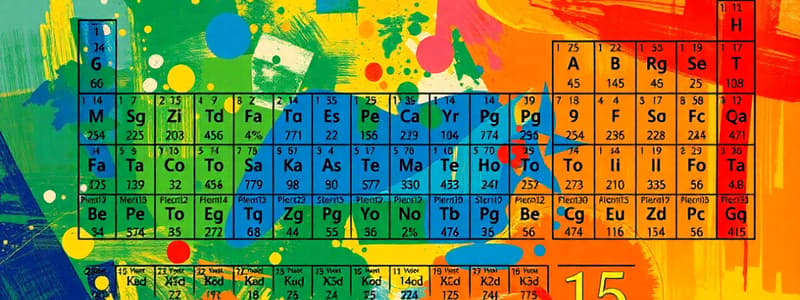Podcast
Questions and Answers
What does the atomic number of an element represent?
What does the atomic number of an element represent?
- The total number of electrons in an atom
- The number of protons in an atom (correct)
- The mass of the atom in atomic mass units
- The number of neutrons in the nucleus
Which elements are classified as p-block elements?
Which elements are classified as p-block elements?
- Elements in Group 1 and Group 2
- Elements in Group 13 to 18 (correct)
- Elements in the f-block of the periodic table
- Elements in Group 3 to 12
Who is credited with the creation of the first periodic table?
Who is credited with the creation of the first periodic table?
- Henry Moseley
- Dimitri Mendeleev (correct)
- John Newlands
- Lothar Meyer
What characterizes d-block elements?
What characterizes d-block elements?
Which of the following groups belong to the s-block of the periodic table?
Which of the following groups belong to the s-block of the periodic table?
Flashcards are hidden until you start studying
Study Notes
The Periodic Table: Atomic Number & Groups
- The atomic number of an element is determined by the number of protons in its atoms.
- The periodic table organizes elements into groups, which are vertical columns.
- Groups indicate the number of valence shell electrons in an element's atom.
History of the Periodic Table
- Dobereiner (1817): Grouped elements into triads based on atomic mass and similar properties.
- Newlands (1863): Proposed the "Law of Octaves," suggesting similar properties occur every eight elements when arranged by atomic mass.
- Mendeleev and Meyer (1869): Independently developed the first periodic table, arranged by increasing atomic mass.
- Moseley (1913): Arranged the table by increasing atomic number, based on X-ray experiments, establishing the modern periodic table.
Periodic Table Blocks:
- s-block: Includes Group 1 (alkali metals) and Group 2 (alkaline earth metals), with electron configurations of ns1 and ns2 respectively.
- p-block: Encompasses Groups 13 to 18.
- d-block: Found in the center of the periodic table, containing Groups 3 to 12. Characterized by filling of inner d orbitals.
- f-block: Includes the two rows of elements at the bottom, the lanthanoids (Ce - Lu) and actinoids (Th - Lr). These elements are known as inner-transition elements due to the filling of f-orbitals.
Hydrogen Bonding:
- Intermolecular hydrogen bonding: Occurs between different molecules of the same or different compounds. Examples: water, alcohol, and ammonia.
- Intramolecular hydrogen bonding: Occurs within a single molecule. Examples: o-nitrophenol.
Significance of Hydrogen Bonding:
- Slow evaporation of water
- Flexibility of muscles
- Water retention in soil
- Enhanced solubility of substances
- Effectiveness of drugs
- Strength of cement concrete
- Elasticity of nylon polymer
Mole Concept:
- Mole: Unit of measurement for the amount of a substance, containing as many particles as there are atoms in 12g of the carbon-12 isotope.
- Molar mass: Mass of one mole of a substance expressed in grams.
- Mole fraction: Ratio of the moles of a component to the total moles in a mixture. It is unitless.
Solutions:
- Molarity (M): Number of moles of solute per liter of solution.
- Molality (m): Number of moles of solute per kilogram of solvent.
- Normality (N): Number of equivalents of solute per liter of solution.
Solid Structures:
- Ionic solids: Composed of positively and negatively charged ions.
- Network solids: Characterized by a continuous network of atoms held together by covalent bonds.
- Mica: A two-dimensional network solid containing one silicon atom bonded to three oxygen atoms and one monovalent atom, forming a stable molecule with a planar shape.
- Quartz: A three-dimensional network solid with one silicon atom bonded to four oxygen atoms, creating a stable molecule with a tetrahedral shape and a high melting point.
Crystallization of Inorganic Salts:
- Process: Heat a solution, evaporate solvent, cool the solution, collect and dry crystals, filter undissolved solids.
- Factors affecting crystal size: Cooling rate (faster cooling results in smaller crystals, slower cooling in larger crystals).
Checking Your Knowledge:
- Ionic radius: Be2+ is smaller than O2-.
- Electron affinity: Generally increases across a period.
- Electronegativity: Caesium (Cs) has the lowest electronegativity.
- Coordinate covalent bond: One atom provides both electrons in the bond.
- Arrangement of atoms: Zinc (Zn) is not from the same category as gold (Au), silver (Ag), and copper (Cu). They are all transition metals, but zinc is not a noble metal.
Studying That Suits You
Use AI to generate personalized quizzes and flashcards to suit your learning preferences.



